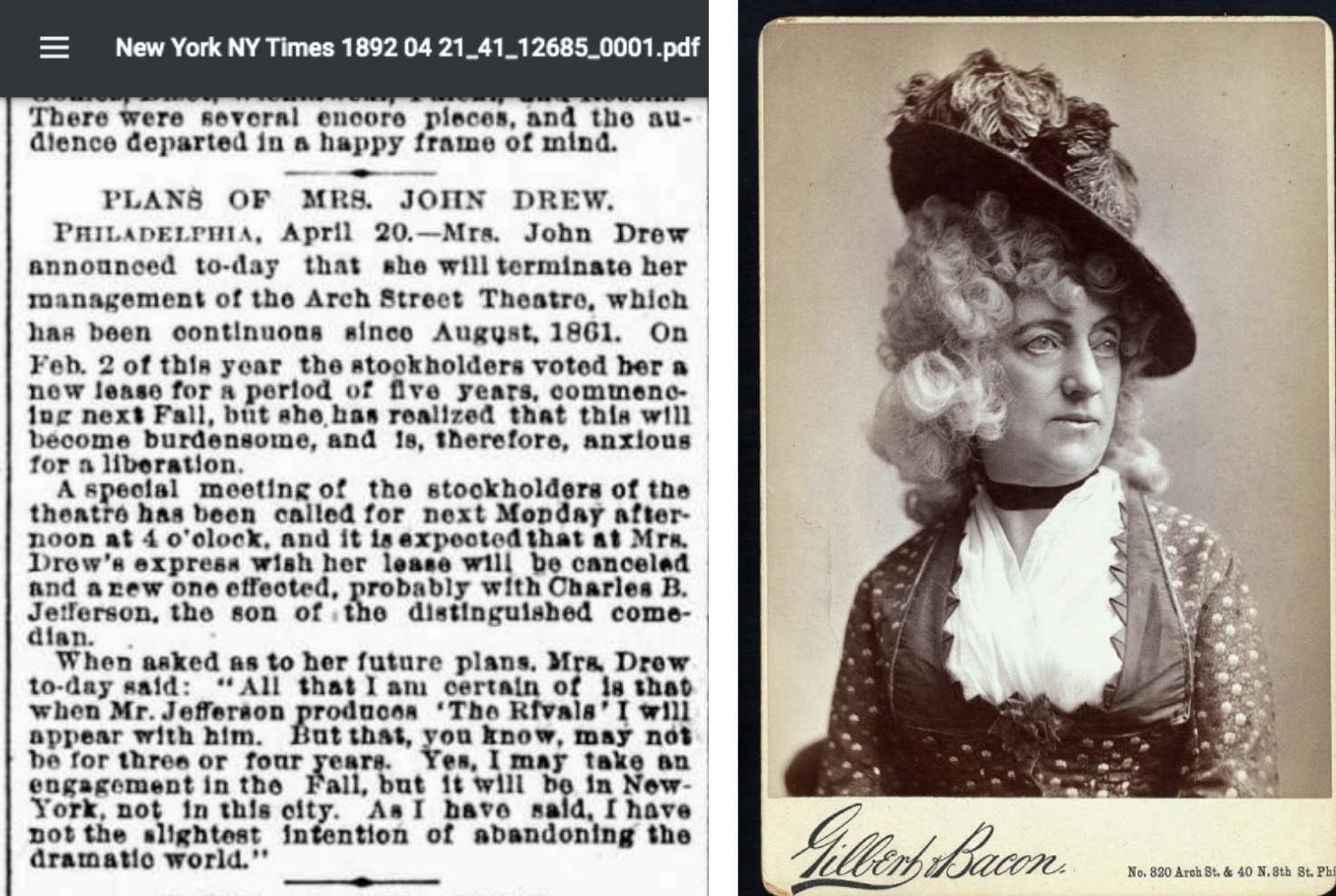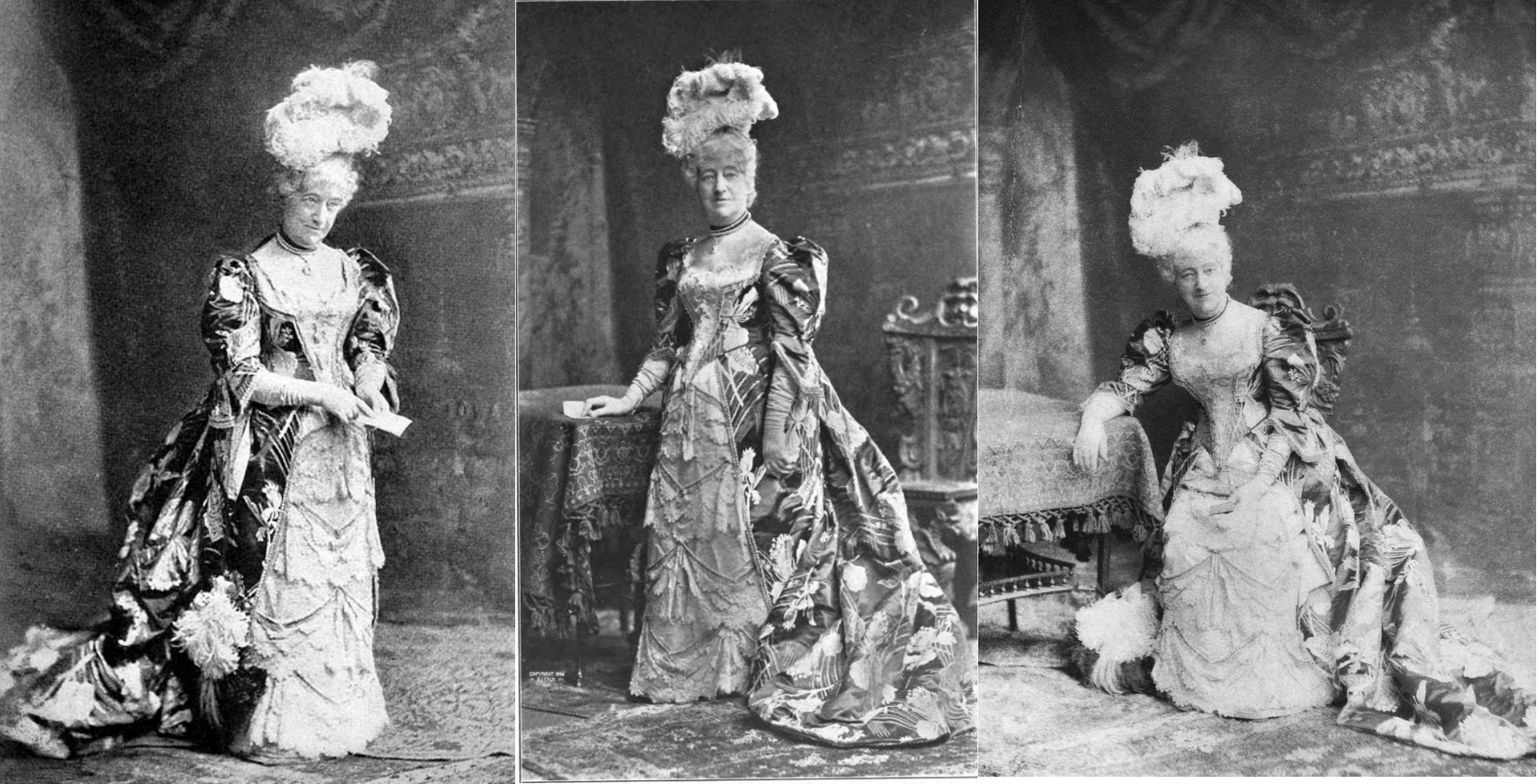
Above: An 1863 engraved advertising card for the Arch Street Theatre, with an illustration of the theater's new facade. Collection of the Library Company of Philadelphia
Below, an 1868 photograph of the Arch Street Theatre, taken from the upper floors of a building across the street. This photograph is also from the collection of the Library Company. The statue (almost a bas-relief) of Apollo can be clearly seen, as can the face of another theater god, perhaps Dionysus, which was added to the cornice in 1863.
It is my own pet theory, by the way, that the four people in this photo are Louisa's children. I discuss this theory in my book Adventures in Theater History: Philadelphia.
Below are two of the final playbills for John Drew Sr.'s run of 100 performances at the Arch Street Theatre, shortly before his death. I think him doing the 100 shows was sort of a stunt, and they certainly milked the publicity. They even did a little countdown as they went by - as you can see these are the shows he did for the 94th and the 96th performances. Though it's not stated anywhere again I have the suspicion that this was John's way of paying off his debt, as it were, to Louisa, and that after this it was understood that their marriage was over and that he would not perform for her anymore. But his sudden accidental death made that all too true.
Interestingly, in her memoirs Louisa states that John Drew lingered for three days after falling down the stairs, but the newspaper accounts I have seen make it clear that he died the next day. As I mentioned in the first episode about her, Mrs. Drew's memory wasn't all that reliable in her last years. (These playbills are in the Theatre Collection of the Rare Book Department of the Free Library of Philadelphia.)
Below, photos of Louisa Lane Drew and John Wilkes Booth from the early 1860s, along with a poster for the evening performance of March 6th, 1863, in which they performed Shakespeare together - well, sort of. It's likely that the version of The Merchant of Venice that they did was a highly edited 'star' version that Booth used to show off his particular talents, with the other roles heavily cut. Catharine & Petruchio, for its part, was a shorter version of The Taming of the Shrew that had been edited and re-written by the actor David Garrick back in the 18th Century. It was often trotted out as a showy comic classic piece well into the following century, as we can see here.
I would like to make it clear, by the way, that John Wilkes Booth is one of my LEAST favorite people in Theater History - indeed, in world history overall. He was a vicious white supremacist and his action - which resulted in the completely inadequate Andrew Johnson becoming President - destroyed all hope of a true Reconstruction and Reconciliation with some measure of racial justice after the Civil War. Whether he was actually a good actor or not is hardly even an interesting question, the consequences of the act he is remembered for outweighs the matter so much. He would have been just a minor star of the 19th Century stage, forever in the shadow of his much more talented brother Edwin, if he had not killed Abraham Lincoln. I wish we could forget all about him, but we can't.
I may cover the Booth Family more in a subsequent episode, but maybe not. They've been covered pretty extensively elsewhere.
Below, a photo of Mrs. Drew from the 1870s, at which point she was clearly beginning to show her age. Alongside are three posters from three performances that I mention during the podcast: Love's Labour's Lost and Scotto in 1862, Surf! in 1867, and Maum Cre in 1874.
Above, John Drew Jr. as he appeared in 1873, about the time of his Arch Street Theatre debut in Cool as a Cucumber, an old reliable one-act skit written by the British comedian Charles Matthews. But the entire evening was really a benefit performance for his younger sister Georgie, who was already well-known and quite popular on the Philadelphia stage. She was doing a two act play, More Precious Than Gold. The 'benefit' performance would have been regarded as quite old-fashioned by then, much like the stock company model of theater organization itself. Indeed this is one of the last times I see one advertised on an Arch Street Theatre poster, or anywhere else in Philadelphia theater.
Below, the stunningly beautiful couple of Maurice and Georgie Barrymore, about the time of their marriage in 1876. I know I gave rather short shrift to this fascinating couple in the episode, but then, it was a story about Mrs. Drew, and I fought hard not to let their narrative overwhelm hers. Again, there are loads of books written about the Barrymores and their even more famous offspring. I cite some in the Bibliography, below. They are all worth reading. Below that is a famous photo, much reproduced, of Georgie surrounded by her three children: Ethel, Lionel, and John. But I believe it actually dates from after the family had already left Mrs. Drew's home in Philadelphia. Mrs. Drew thereafter would travel to visit them in their summer home on Staten Island, and she continued to dote on her grandchildren all her life, and even once gave Lionel a small part in The Rivals when he was fifteen. He didn't do well, unfortunately, and she gently took the part away from him again. He didn't really mind, though - he liked drawing better, at the time, and was determined to become an artist.
(Note: Since recording the podcast episode, I've subsequently learned that I pronounced the Barrymore children's pet name for their grandmother. In her autobiography, Ethel writes that emphasis should be places on the second syllable: "mumMUM".)
Here are side by side photos of Sidney Drew and his mother from the 1890s. As Lionel once wrote, long afterwards: "Mrs. Drew, of course, may say whatever she wishes in the matter, but Uncle Googan certainly looked like her!" Ethel Barrymore, for her part, was even firmer: "Uncle Sidney may not have been the son of John Drew, but he was indisputably the son of Mrs. John Drew."
I'm not sure why Sidney is shown in a playing card in this image of him that I found online. But he was known as a gambler. He also was an actor, and can even be seen in some short comic films from early Hollywood. Mrs. Drew did let him be the producer of some of her final tours of The Rivals.
Above: An article in the New York Times announcing that Mrs. Drew was leaving the management of the Arch Street Theatre. To the right and below, some of the many delightful photographs taken of her in the role of Mrs. Malaprop.
Here is a very interesting Curtain Call photo of the entire company of the final touring production Louisa Drew and Joseph Jefferson did of The Rivals. I am indebted to the work of Carla Cushman in her article "The 1896 Production of Sheridan's 'The Rivals'" in Stage Whispers (see Bibliography, below). There were a few other plays that she attempted in her final years, but by this point Mrs. Drew was finally having some trouble with her lines, which naturally upset her to no end.
Above, two memorials, the only remaining things standing of all Mrs. Drew's years in Philadelphia. One is the gravestone for her and Mr. Drew, and the other is a historical marker outside the former location of the Arch Street Theatre near Sixth Street. Every building that was on the block in her day is now completely obliterated. It is now the site of the Federal Reserve Bank.
Both of these markers have undergone some revision. As we mention in the podcast, the Drew and Barrymore family graves were relocated when the Greenwood Cemetery was closed. (It is now the site of the James Weldon Johnson Public Housing project.) The graves were moved to Mount Vernon Cemetery, to the north of Laurel Hill Cemetery in Philadelphia. The blue historical marker about the Barrymores originally stood on 12th Street outside the former family home. But when that, too, was appropriated for a different purpose in 1986 - to construct the Philadelphia Convention Center - a similar sign was placed instead outside the location of the Old Arch Street Theatre. But, as I say in the episode, it's annoying that it mostly talks about the Barrymore siblings, because they did not perform there. Sadly, the sign doesn't even mention Louisa Lane Drew by her full name.
Selected Bibliography
Books & Dissertations:
Alpert, Hollis, The Barrymores, The Dial Press, 1964, pp. 3-67.
Barnes, Noreen Claire, " 'Actress of All Work': A Survey of the Performance Career of Louisa Lane Drew", PhD Thesis, Tufts University, 1986.
Barrymore, Ethel, Memories: An Autobiography. Harper & Brothers, reprinted by Kraus Reprint Co., 1968.
Beasley, David, McKee Rankin and the Heyday of the The American Theater, Wilfrid Laurier University Press, 2002. (The chapter entitled "1865-1866: Leading Man, Philadelphia" on pp. 49-60 deals directly with the actor's time in Mrs. Drew's stock company.)
Drew, John, My Years Upon the Stage, E.P. Dutton & Co., 1922.
Drew, Louisa Lane, Autobiographical Sketch of Mrs. John Drew, with an Introduction by her son John Drew, (notes by John Taylor), Charles Scribner's Sons, 1894.
Glazer, Irving R., Philadelphia Theatres, A-Z: a Comprehensive, Descriptive Record of 813 Theatres Constructed Since 1724, Greenwood Press, 1986, pp. 61-62.
Morgan, Kathleen Anne, "Of Stars & Standards: Actress-Managers of Philadelphia and New York," PhD Thesis, University of Illinois at Champaign-Urbana, 1989.
Peters, Margot, The House of Barrymore, Alfred A. Knopf, 1990, pp. 9-45.
Turner, Mary M., Forgotten Leading Ladies of the American Theatre, McFarland & Company, Inc., 1990, pp. 86-101.
Articles and Websites:
Bank, Rosemarie K., "Louisa Lane Drew at the Arch Street Theatre: Repertory and Actor Training in Nineteenth-Century Philadelphia," in Theatre Studies, No. 24125.
Cushman, Carla, "The 1896 Production of Sheridan's 'The Rivals'" in Stage Whispers (website). https://carlacushman.blogspot.com/2009/07/1896-revival-of-sheridans-rivals.html
Colimore, Edward, "John Wilkes Booth Honed His Acting While At Philadelphia's Arch Street Theatre," The Philadelphia Inquirer, published March 17, 2013. https://www.inquirer.com/philly/news/20130302_John_Wilkes_Booth_honed_his_acting_while_at_Philadelphia_s_Arch_Street_Theatre.html
Lindsay, Suzanne Glover, "The Drews and Barrymores at St. Stephens, Part II", blog post on St. Stephen's Episcopal Church website, dated September 16, 2019. https://www.ststephensphl.org/news/the-drews-and-barrymores-at-st-stephens-part-ii/9-2019
Pawlack, Debra Ann, "Lady in Charge," Pennsylvania Heritage (website), dated Summer 2014. (Originally an article in Pennsylvania Heritage Magazine, Volume XL, Number 3) http://www.phmc.state.pa.us/portal/communities/pa-heritage/louisa-lane-drew-lady-in-charge.html
"Pennsylvania Oilman John Wilkes Booth," Iron Brigadier: Civil War Info and Resources (website), published October 24, 2012, updated August 21, 2018. https://ironbrigader.com/2012/10/24/pennsylvania-oilman-john-wilkes-booth/
"A Veteran Actor", The New York Dramatic Mirror, August 17, 1901. (Interview with John. L. Saphore. Accessed via Old Fulton New York Postcards website)
"An Entertaining Reminiscence", by Russ Whytal in The New York Dramatic Mirror, May 25, 1895. (Accessed via Old Fulton New York Postcards website)
"My Reminiscences", Ethel Barrymore scrapbook. Spencer Berger Collection on Film, Theater, and Music. Yale Collection of American Literature, Beinecke Rare Book and Manuscript Library online collection. https://collections.library.yale.edu/catalog/17175826




















